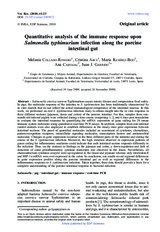Mostrar el registro sencillo del ítem
Quantitative analysis of the immune response upon Salmonella typhimurium infection along the porcine intestinal gut
| dc.contributor.author | Collado-Romero, Melania | |
| dc.contributor.author | Arce Jiménez, Cristina | |
| dc.contributor.author | Ramírez-Boo, M. | |
| dc.contributor.author | Carvajal, Ana | |
| dc.contributor.author | Garrido, Juan J. | |
| dc.date.accessioned | 2013-09-20T12:01:38Z | |
| dc.date.available | 2013-09-20T12:01:38Z | |
| dc.date.issued | 2010 | |
| dc.identifier.uri | http://hdl.handle.net/10396/10953 | |
| dc.description.abstract | Salmonella enterica serovar Typhimurium causes enteric disease and compromises food safety. In pigs, the molecular response of the intestine to S. typhimurium has been traditionally characterized by in vitro models that do not reflect the actual immunological competence of the intestinal mucosa. In this work, we performed an oral S. typhimurium infection study to obtain insight into the in vitro response in three different sections (jejunum, ileum and colon) of the porcine intestine. For this, samples from onemonth- old infected piglets were collected during a time course comprising 1, 2, and 6 days post inoculation to evaluate the intestinal response by quantifying the mRNA expression of gene coding for 28 innate immune system molecules using quantitative real-time PCR assays. In addition, samples from non-infected control animals were also employed to establish differences in the steady state gene expression between intestinal sections. The panel of quantified molecules included an assortment of cytokines, chemokines, pattern-recognition receptors, intracellular signaling molecules, transcription factors and antimicrobial molecules. Changes in gene expression occurred in the three different parts of the intestine and during the course of the S. typhimurium infection. Moreover, the high variation observed in expression patterns of genes coding for inflammatory mediators could indicate that each intestinal section responds differently to the infection. Thus, on the contrary to findings in the jejunum and colon, a down-regulation and lack of induction of some proinflammatory cytokine transcripts was observed in the ileum. Nevertheless, all chemoattractant cytokines assayed were up-regulated in the ileum and jejunum whereas only interleukin-8 and MIP-1a mRNA were over expressed in the colon. In conclusion, our results reveal regional differences in gene expression profiles along the porcine intestinal gut as well as regional differences in the inflammatory response to S. typhimurium infection. Taken together, these data should provide a basis for a complete understanding of the porcine intestinal response to bacterial infection | es_ES |
| dc.format.mimetype | application/pdf | es_ES |
| dc.language.iso | eng | es_ES |
| dc.publisher | INRA | es_ES |
| dc.rights | https://creativecommons.org/licenses/by-nc-nd/4.0/ | es_ES |
| dc.source | Veterinary Research 41: 23 (2010) | es_ES |
| dc.subject | Salmonella | es_ES |
| dc.subject | Pig | es_ES |
| dc.subject | Intestinal gut | es_ES |
| dc.subject | Immune response | es_ES |
| dc.subject | real-time PCR | es_ES |
| dc.title | Quantitative analysis of the immune response upon Salmonella typhimurium infection along the porcine intestinal gut | es_ES |
| dc.type | info:eu-repo/semantics/article | es_ES |
| dc.rights.accessRights | info:eu-repo/semantics/openAccess | es_ES |

